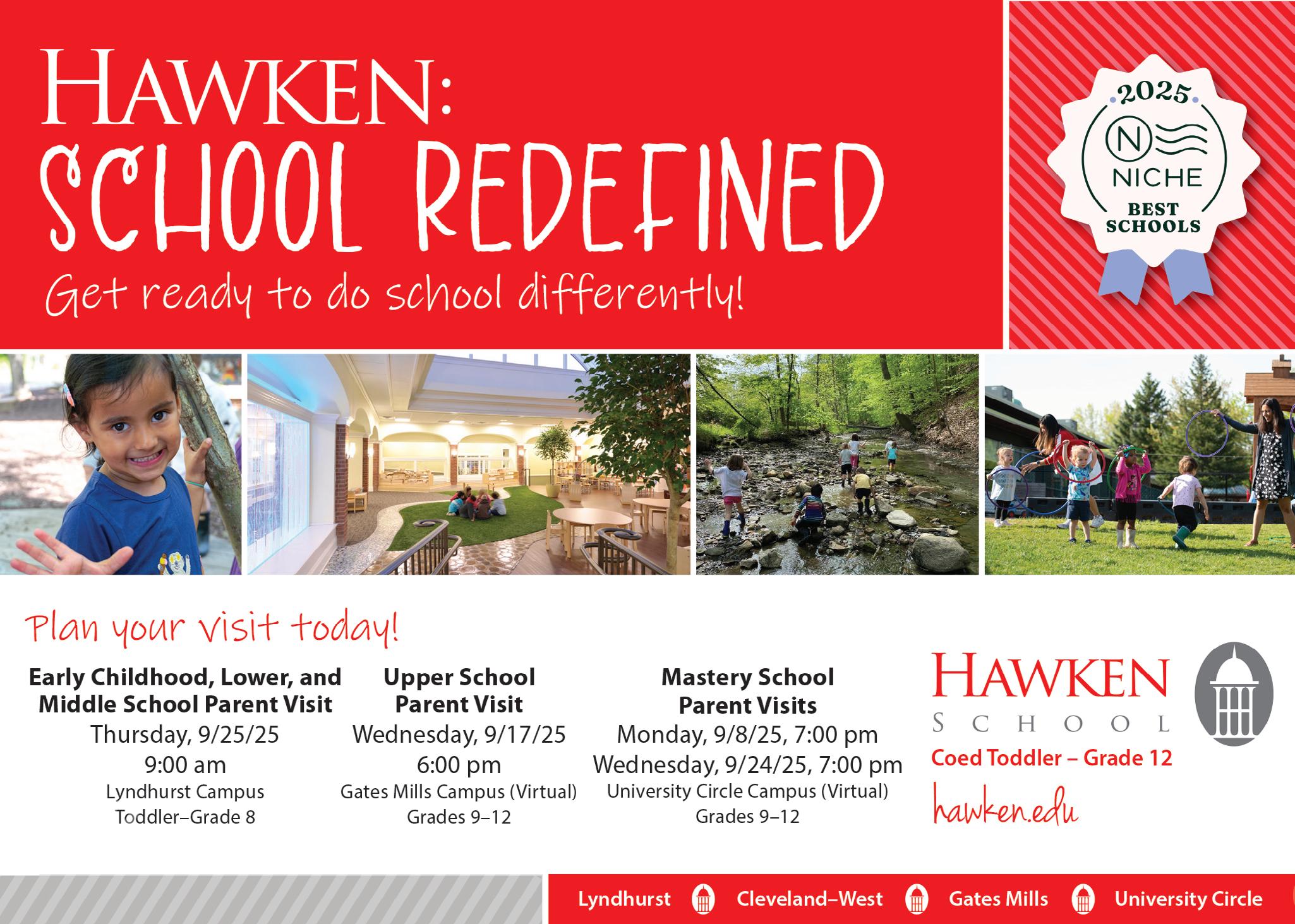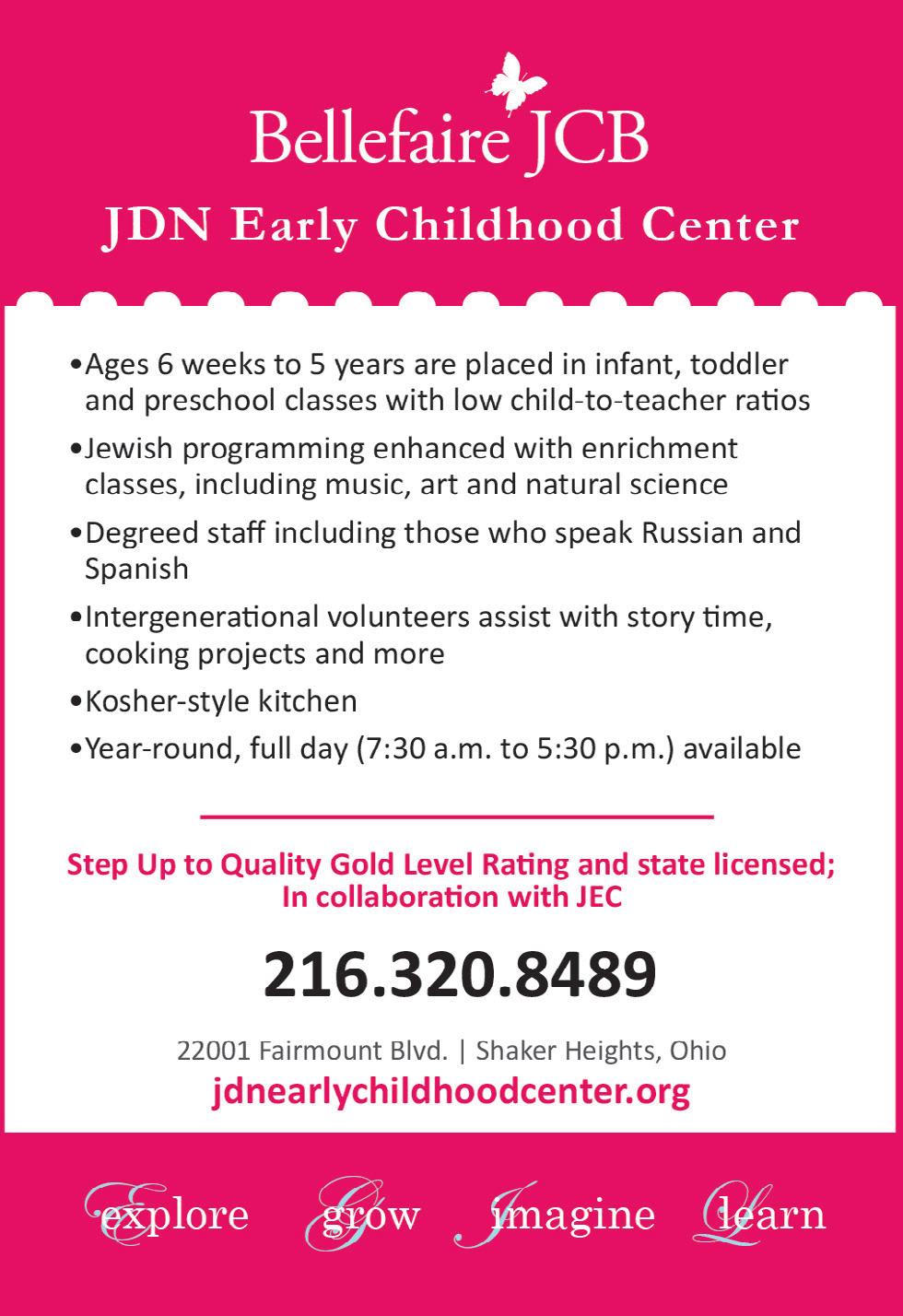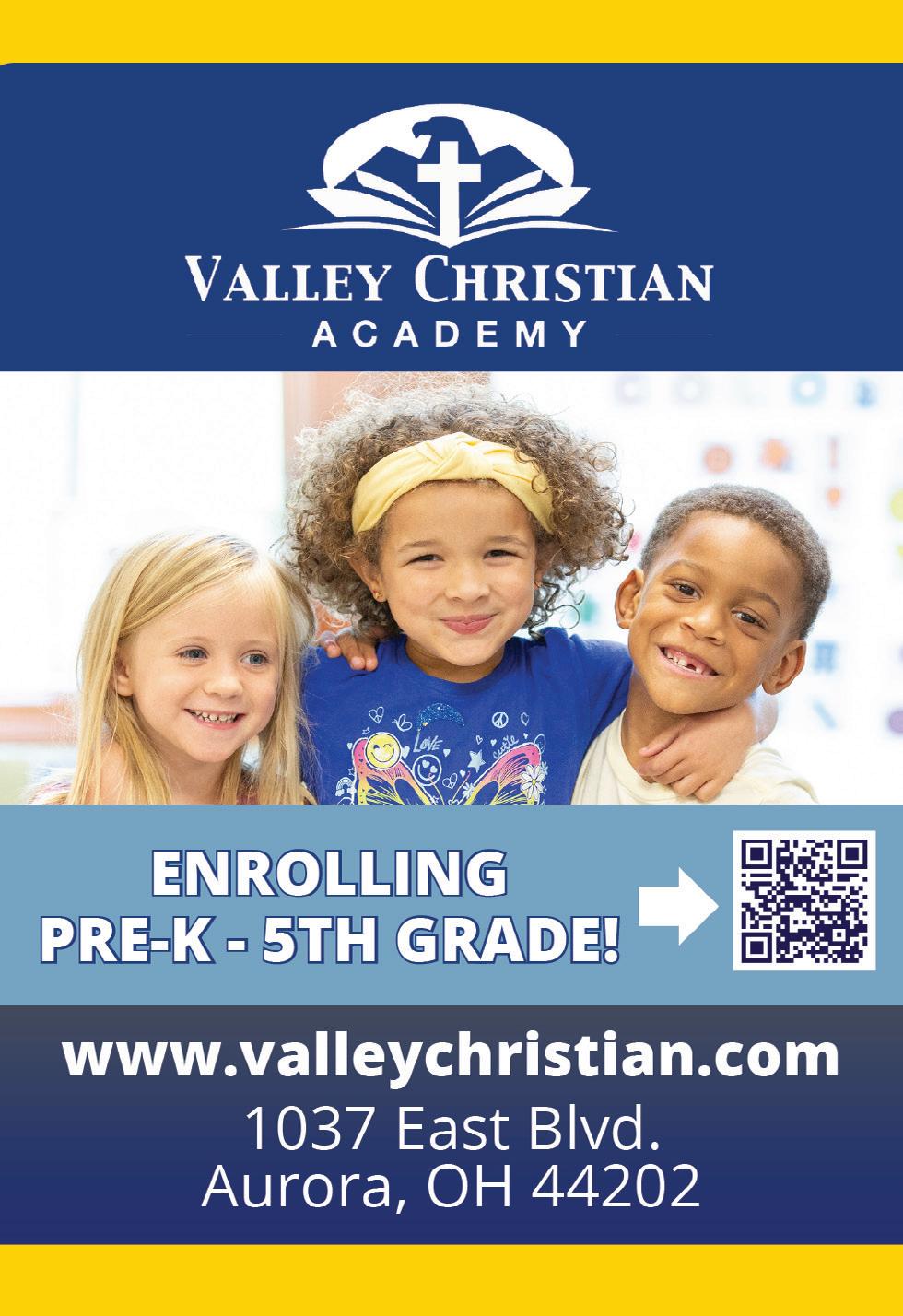

Raising Little Listeners
How to Teach Preschoolers to Follow Directions
By Aisha Taylor
Have you ever felt like you’re speaking a different language when asking your preschooler to do a simple task? A seemingly simple request, like “Put on your shoes and grab your backpack,” can feel like a different
language — or worse, it can spark an epic battle of wills complete with a full-blown meltdown. If you’ve ever felt completely exasperated and unsure of what to do, you’re definitely not alone.

WHAT MAKES IT SO HARD FOR PRESCHOOLERS TO FOLLOW DIRECTIONS?
Preschoolers, typically ages 3 to 5, are navigating a period of major developmental growth. While their skills and independence are rapidly expanding, there are still many things they are physically and developmentally unable to do.
The first step to helping them follow directions is to ensure they are physically able to do so. Dr. W. Kyle Mudd, a general pediatrician at the Cleveland Clinic, notes that “pediatric well checks aren’t just about vaccines.” During these visits, doctors provide “anticipatory guidance,” letting parents know what to expect in their child’s development, what’s considered normal, and addressing any parental concerns. During these checkups, pediatricians also test the child’s vision and hearing, as these can significantly impact their ability to follow directions.
Beyond physical development, other factors can make it difficult for children to follow directions. According to Mudd, if children aren’t feeling well, have an earache, are sleep-deprived, or are dealing with a major life change such as a new sibling, a move, or a parent’s divorce, “we can expect them to really struggle with following directions.
“We need to give them some slack, because they’re dealing with a fraction of the brain power and ability to follow through with requests.”
Sometimes, the difficulty lies not with the child, but with the way directions are given.
Carrie Serafimov, who has years of experience as a junior kindergarten teacher and now oversees the Early Childhood Program and is the lower school assistant principal at Heritage Classical Academy in Peninsula, says, “A lot of times, adults talk too much. We give three, four or five directions at once and just assume a 3- to 5-year-old child should be able to do it. We need to pull it back.”
The good news is that this is an easy adjustment for parents to make.
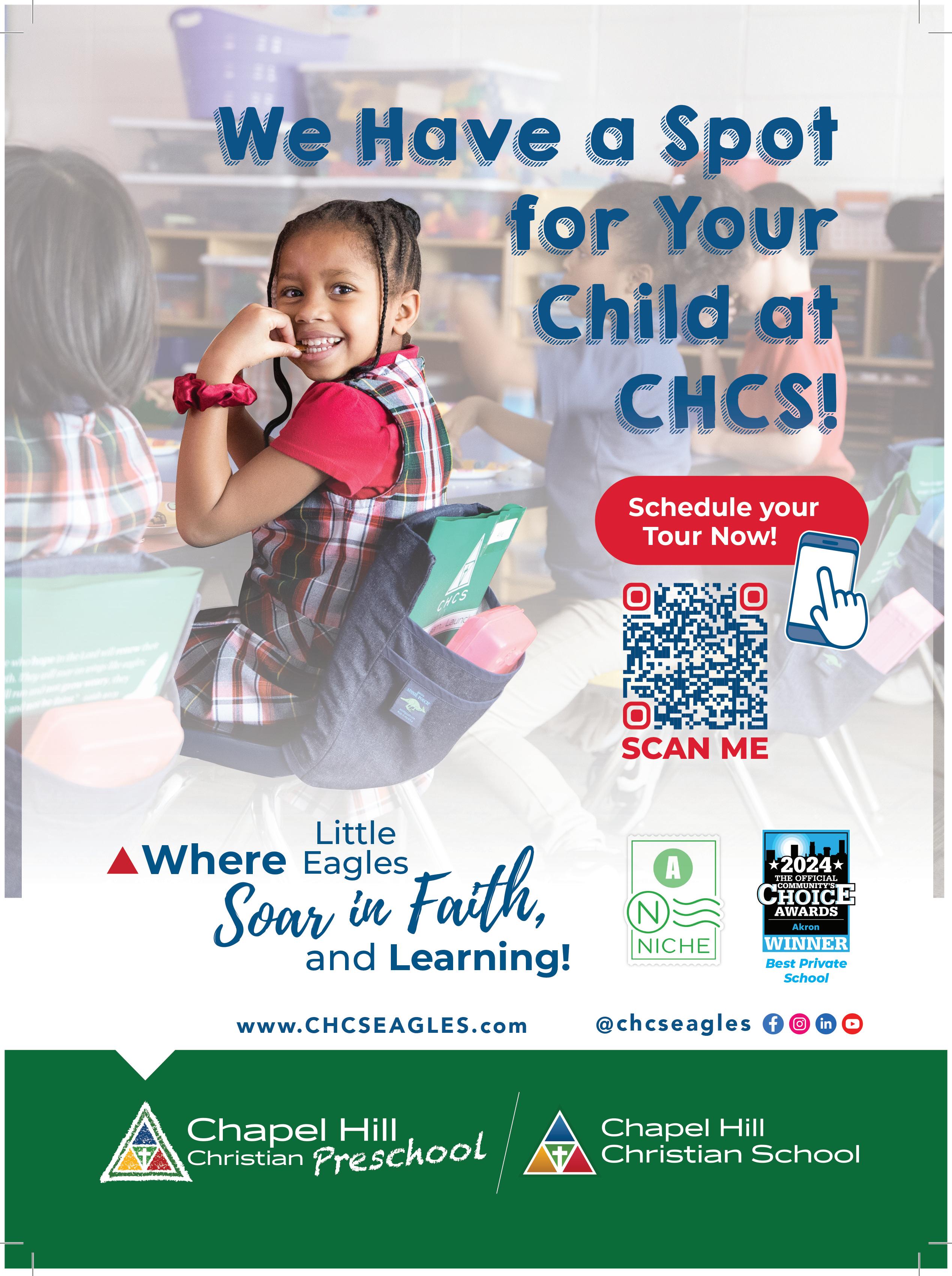
FOLLOW DIRECTIONS:
• Make sure you have your child’s full attention.
• Before giving a direction, get down to the child’s eye level and make eye contact. Gently place a hand on the child’s shoulder or hold their hand to ensure you have their attention.
• Try to minimize distractions. Serafimov suggests at home, “Make sure the TV is off when you’re giving directions. If not, that will be a distraction and a barrier to obedience.”
• If you’re in a chaotic or loud environment, like a park, consider using a unique tone of voice.
• “Whispering the direction or your child’s name, if you’re within close proximity, gets his or her attention by saying it a little bit differently,” Serafimov says. “Always start with your child’s name so he or she knows who you are speaking to.”
ADJUST HOW YOU GIVE DIRECTIONS
Stick to one direction at a time, or the number that’s developmentally appropriate for your child. A 5-year-old can handle two or maybe three steps, depending on the complexity.
Try giving directions in distance order. Serafimov offers an example for cleaning a toy room: “If the blocks are the closest, I would ask the child to clean up the blocks first, then the coloring items a little further away, and then across the room to clean up the dolls.”
This helps minimize distractions along the way. After giving the instructions, ask your child to repeat them back to you to ensure understanding.
USE VISUAL AIDS
Visual aids are staples in preschool classrooms and can be incredibly helpful at home. They can be used to help children stay on track and reduce parent and child frustration. You can order visual aids online or create your own charts for morning and nighttime routines. The visual aid should show each step in order. Walk your child through the chart and explain each step, then place it in a logical spot.
“If you have a bedtime routine visual aid, it shouldn’t be in the kitchen,” Serafimov says.
MANAGE TRANSITIONS SMOOTHLY
Transitions from one activity to another can be difficult for children.
Mudd recommends putting yourself in
your child’s shoes.
“I think sometimes parents forget children are people,” he says. “We would get pretty angry if someone just took our laptop while we were in the middle of something and closed it.”
Give your children a warning, like “Five minutes until we leave.” If your children are in the middle of an activity or game, allow them to finish the task, which provides a sense of closure. Being aware of what your children are involved in before giving a directive can greatly increase their compliance.
COMMUNICATE EXPECTATIONS IN ADVANCE
As parents, we often assume our children can infer our expectations, but that’s not the case.
Serafimov suggests setting expectations ahead of time and even turning it into a game. First, parents can describe the place or activity. Then ask your child prompts like:
• “Can you please tell me how we should act while we are there?”
• “What are some things I can do as a mom to make this go smoothly?”
• “What can you do to help this go smoothly?”
• “How do you think we are going to leave?”
For example, before heading to the park, parents can say, “We are going to stay for one hour. When we have five minutes left, I will let you know. Then, when I say, ‘Joe, it’s time to go,’ I don’t want any distractions or disagreements. Why don’t you tell me what your reaction is going to be when I say it’s time to go?”
When your child processes the request and tells you what leaving well looks like, he is not just listening — he or she is thinking and processing ahead of time. This helps parents communicate expectations more clearly and increases the success of the outing.
Additionally, be clear about the consequences.
Serafimov suggests saying, “If we leave well, we can come back and do this again. If we don’t, we’re not going to do this outing again for a while.” Parents can also revisit a past outing that didn’t go well and ask their children what could happen this time to make it go better. This helps children learn to think through their choices.
KNOW YOUR CHILD
Understanding how your child reacts to different situations helps parents give directions in the most effective way. Ask yourself:
• How does he or she react to different situations?
• How does lack of sleep affect them?
• How does outside stimuli affect them?
• How do certain foods affect mood?
When a child seems rebellious, knowing your child helps get to the root of the issue.
Before jumping to conclusions or getting frustrated, pause and ask yourself: Is this a miscommunication? Is my child distracted? Does my child physically feel equipped to follow this direction?
Sometimes, a child is being genuinely disobedient. In those moments, Serafimov advises holding the child accountable and having a calm conversation.
Ask: “Why don’t you want to do this? What is it that you want to do that’s not the direction I’ve given you?” Parents may decide to modify their instructions, or they may need to apply a consequence to teach the child about obedience.
RED FLAGS TO WATCH FOR
In some cases, a child’s consistent inability to follow instructions may signal a deeper issue, such as a developmental or cognitive challenge. If you have concerns, speak with your pediatrician or your child’s preschool teacher to determine if a follow-up evaluation is necessary.
STAYING THE COURSE: PATIENCE AND CONSISTENCY ARE KEY
Helping your child follow directions can be a frustrating and draining process. As Serafimov reminds us, “Preschoolers are notorious for pushing boundaries. They want to do things their own way and in their own time, so please be patient and consistent. This is difficult, but parents, you can do it. You’re equipped to guide and lead your children.”
The foundation you’re laying now will pay off in the long run by preparing your child for success in school and later in life.
Mudd adds, “Kids can become oppositional when we ask too much of them and they are constantly being told they are doing something wrong.”
He stresses developmentally appropriate expectations and patience are a must.
“Our typical responses to our children not following directions are often influenced by how we were raised,” he says. “Developing these new skills of patience and setting appropriate expectations may require a lot of inner work, rewiring and reteaching ourselves how to respond, which is difficult, but very important if we want to raise well-adjusted children.”

ipleH n g Preschoolers UnderstandTheir Fee l i n g s

IBy Erin Nusker
spent time with preschoolers, you know how quickly emotions can roll in and change. One moment a child is laughing, and the next, they’re in tears over a dropped snack or a tag in a shirt. Big feelings are part of the preschool experience — and they can be overwhelming for kids and adults alike.
Asking kids how they’re feeling doesn’t always lead to a clear answer. There are ways to help children describe their emotions using something more familiar and concrete.
WHY WEATHER WORKS FOR EMOTIONAL LEARNING
Helping young children identify and manage emotions is more than just a nice idea — it’s a foundational life skill. When kids learn how to recognize what they’re feeling, they are better equipped to express themselves, build healthy relationships, and respond to challenges in positive ways. Emotional regulation in early childhood lays the groundwork for success in school and beyond, and it starts with giving kids the tools to understand their inner world.
For preschoolers, the concept of emotions can be a source of confusion. Words like “frustrated” or “overwhelmed” may not always resonate.

ThroughPlay
I began using weather as a metaphor. It’s something children see and experience every day. A storm might feel like anger, a soft rainbow like calm, and a rainy day like sadness.
Each type of weather mirrors a different kind of feeling. A tornado feels like anger that spins out of control. Rain reflects sadness that needs to fall. Sunshine captures joy. Wind might represent nervous energy or worry. These are things children can see, hear and experience — so when we connect emotions to weather, we make the invisible visible.
By giving emotions a form that exists in their everyday world, we make it easier for children to describe what they’re feeling without needing advanced vocabulary. They begin to understand that just like a rainstorm passes, so can a sad moment. Just like the wind calms, so can anxious energy. This understanding helps build emotional flexibility—something that supports healthy development long-term.
TANGIBLE TOOLS: ACTIVITIES THAT HELP KIDS FEEL AND UNDERSTAND
Kids learn best by doing. Pairing emotional language with hands-on, sensory activities makes the learning stick.
The experience of touching, seeing and creating something adds an extra layer of understanding — making feelings even more concrete and relatable for young children.
Here are a few simple ways to bring weather-based emotional learning into your home or classroom:
1. Tornado in a Bottle (Anger)
Fill a clear bottle with water, glitter, and a drop of dish soap. When shaken, it becomes a swirling tornado. Use it to show how anger can build— and how it can settle with time.
2. Rain Cloud Experiment (Sadness)
Layer shaving cream on top of water in a clear cup. Use a dropper to add colored water until it “rains.” This is a great visual for the idea that it’s okay to feel full and let it out.
3. Feather or Bubble Breathing (Worry)
Use slow, deep breaths to move a feather across a table or blow bubbles. It turns calming strategies into something kids can feel and play with, while connecting it to the concept of wind.
These aren’t just science activities — they’re regulation tools in disguise. Kids shift from tense to calm just by taking a few bubble breaths. When the activity matches the emotion, learning becomes both fun and meaningful.


LET’S TALK ABOUT ALL THE FEELINGS
One of the most valuable messages we can give kids is that all feelings are valid. Emotions aren’t right or wrong — they’re just signals. Using weather strips away the shame that can sometimes come with big emotions. A “stormy” moment doesn’t make you a bad kid. It just means you need support.
As adults, we often default to “calm down” or “stop crying.” But saying, “Let’s ride this storm together,” creates a connection instead of control. It reminds children that we’re on their team — even when their skies are cloudy.
When a child can say, “Today feels like rain,” they’re not just expressing themselves — they’re learning how to move through their emotions with confidence.
And that’s the kind of emotional literacy that lasts well beyond the preschool years.
Erin Nusker is a kindergarten teacher, curriculum developer, and author of the Cloudy with a Chance of Feelings book series. Her newest book, “Sometimes I Feel Like the Weather,” just released on Amazon. Her work helps young children build emotional awareness using weather metaphors and hands-on learning. Learn more at erinnusker.net.


Early Learning: Finding the Right
Preschool for Your Child
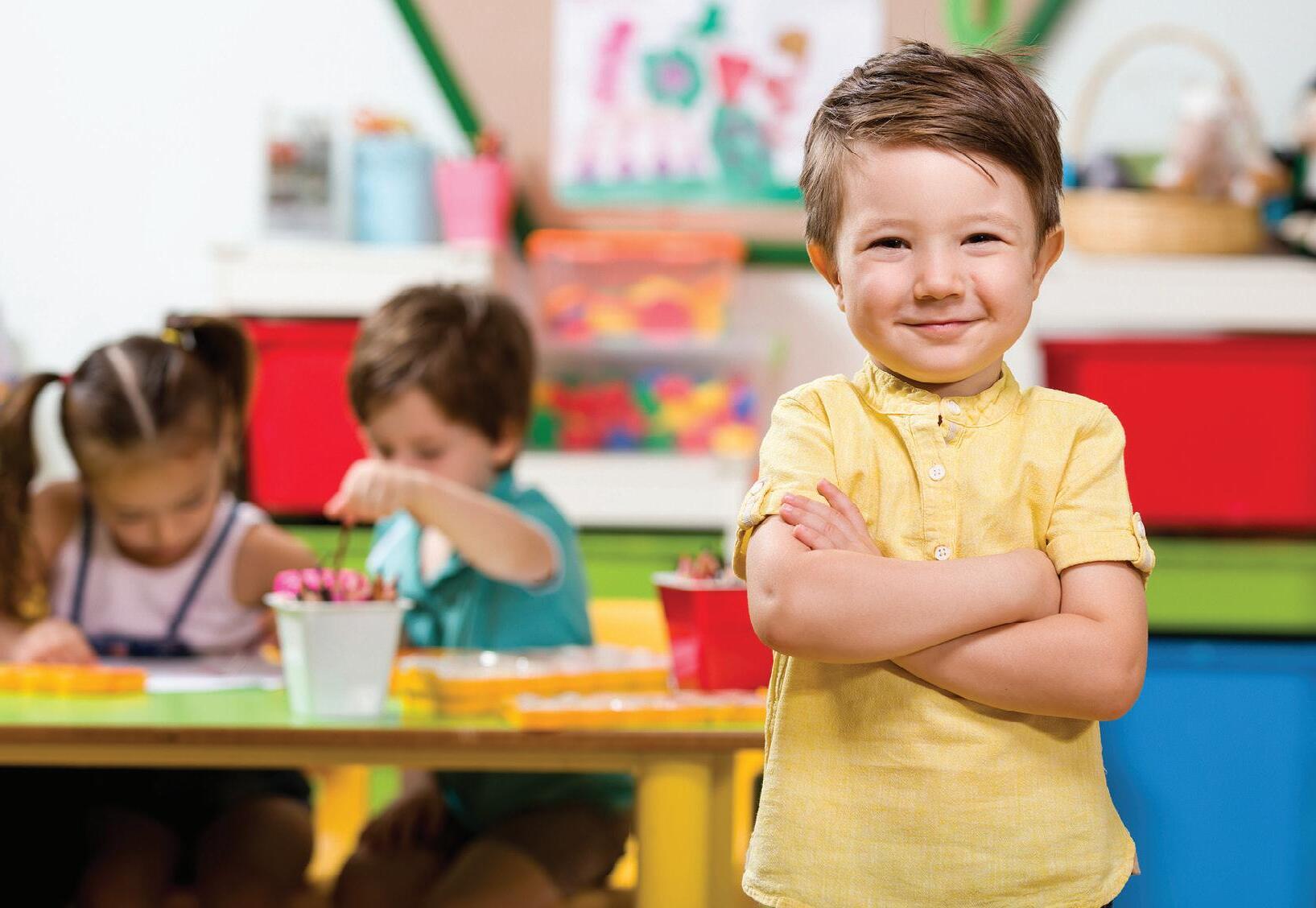
PBy Shana O’Malley-Smith
reschool is more than just crafts, nursery rhymes and snack time — it’s the foundation of your child’s educational journey. It’s where they’ll learn to spell their name, hold a pencil, follow instructions, make friends and navigate the world of learning.
Parents have more preschool options than ever, and the process of choosing the right school can feel overwhelming. Between the different types of teaching styles, cost and how preschool will fit into your family’s schedule, there’s no one-size-fits-all answer. Understanding the different types of preschool programs is a great place to start, as each offers a unique approach to learning.
EARLY CHILDHOOD LEARNING CENTERS
One of the biggest advantages of a daycare or early childhood learning center is the continuity of care. Rather than switching between caregivers or environments, children remain in the same setting with the same teachers and staff, and many of the same families from infancy until they go to kindergarten. Children can start as early as 6 weeks old and transition through classrooms as they grow.
“The functionality of childcare has changed vastly in the past few decades, as the importance of early learning has been well studied and is now a primary focus in the fields of education, child development and behavioral health,” explains Ally Pleveich, assistant director at The Goddard School in Macedonia, who adds that at Goddard School, “preschool classrooms in particular are focused not
only on learning through play, but also on developing academic skills such as early writing skills and word recognition.”
In addition to academic enrichment, early childhood learning centers offer full care services including feedings, naps, diaper changes, flexible hours for working parents and care for siblings.
PRIVATE/INDEPENDENT PRESCHOOLS
Private schools offer unique benefits by providing specialized curriculums, enrichment programs and smaller class sizes. Private and independent schools can vary widely in structure and curriculum design, from religious-based (such as Christian, Catholic and Jewish day schools) to those centered on educational philosophies like Montessori or Waldorf, which emphasize hands-on learning, independence and creativity from a young age.
Private schools foster a close-knit community experience for students as well as parents, promoting a strong sense of belonging. These schools typically have a formal admissions process and deadlines are early. Families should begin planning about a year in advance.
PUBLIC SCHOOL DISTRICT PRESCHOOLS
Some public school districts may offer free or low-cost preschool programs for students who live in the school district. These programs generally focus on kindergarten readiness and follow a traditional school-year calendar. Spots may be limited and filled through a lottery system, based on financial need
or developmental assessments.
OTHER ORGANIZATIONS
Community centers, science and nature centers or music and performing arts centers may offer preschool-age programs or “parent and me” classes for little ones who are just beginning to explore group settings. These may be short classes or seasonal programs that offer children the opportunity to explore fingerplay, dance, movement and simple instruction in a nurturing environment. When it comes to selecting the best preschool, here are a few key tips to help guide your decision:
• Take a Tour: Observe how teachers interact with students, ask for a copy of their daily schedule and get a feel for the overall atmosphere.
• Ask About the Teaching Philosophy: Consider how that aligns with your child’s learning style and personality.
• Consider Practical Details: Look at location, cost, hours of care and how well it fits into your family’s lifestyle.
• Talk to Other Parents: Reviews and personal experiences can be helpful in narrowing down your options. Ask questions about communication, safety and what their child has gained from the program.
• Sometimes, it comes down to a feeling: The right preschool should feel like a place where your child will be supported, challenged and excited to learn.
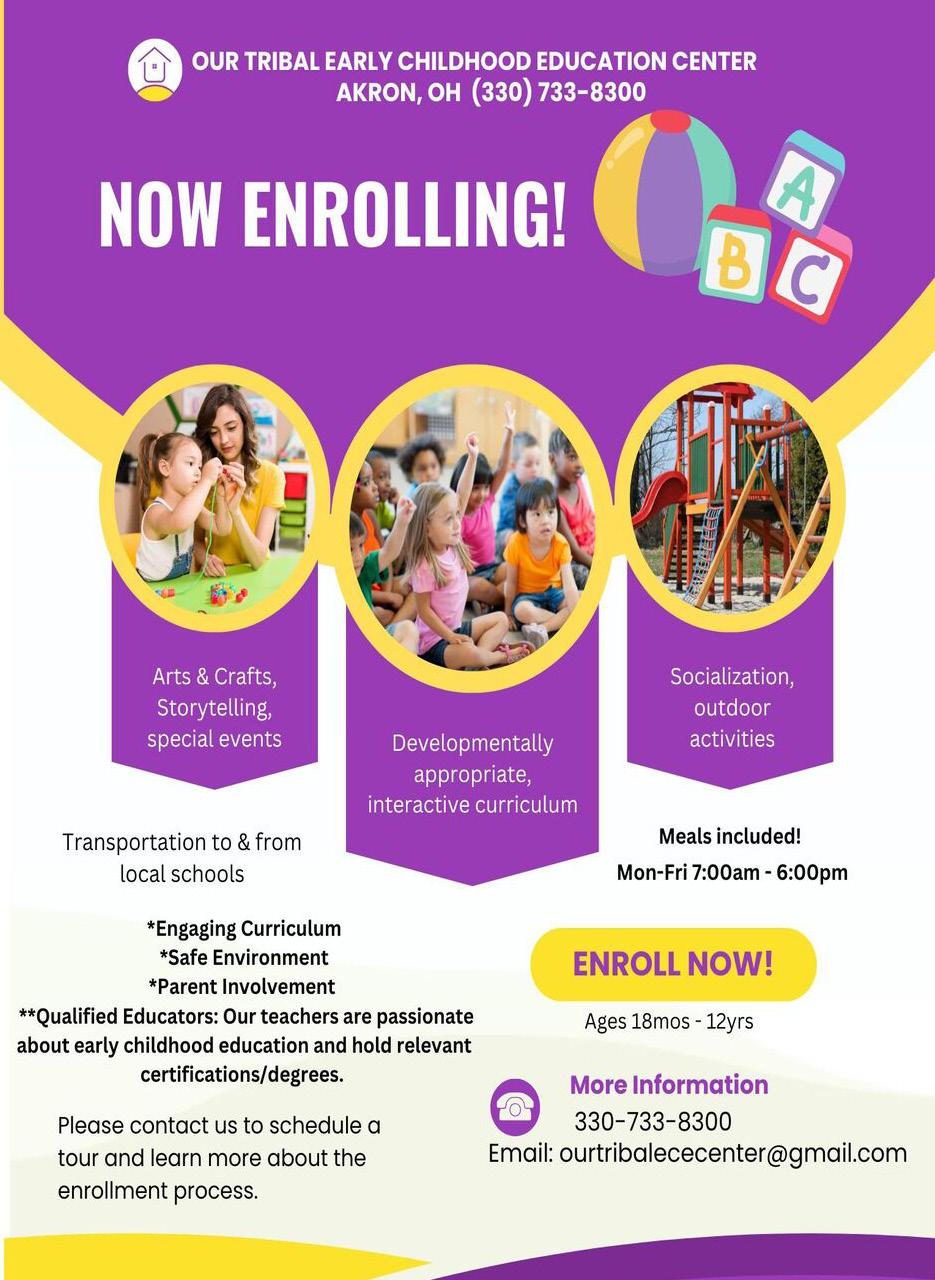
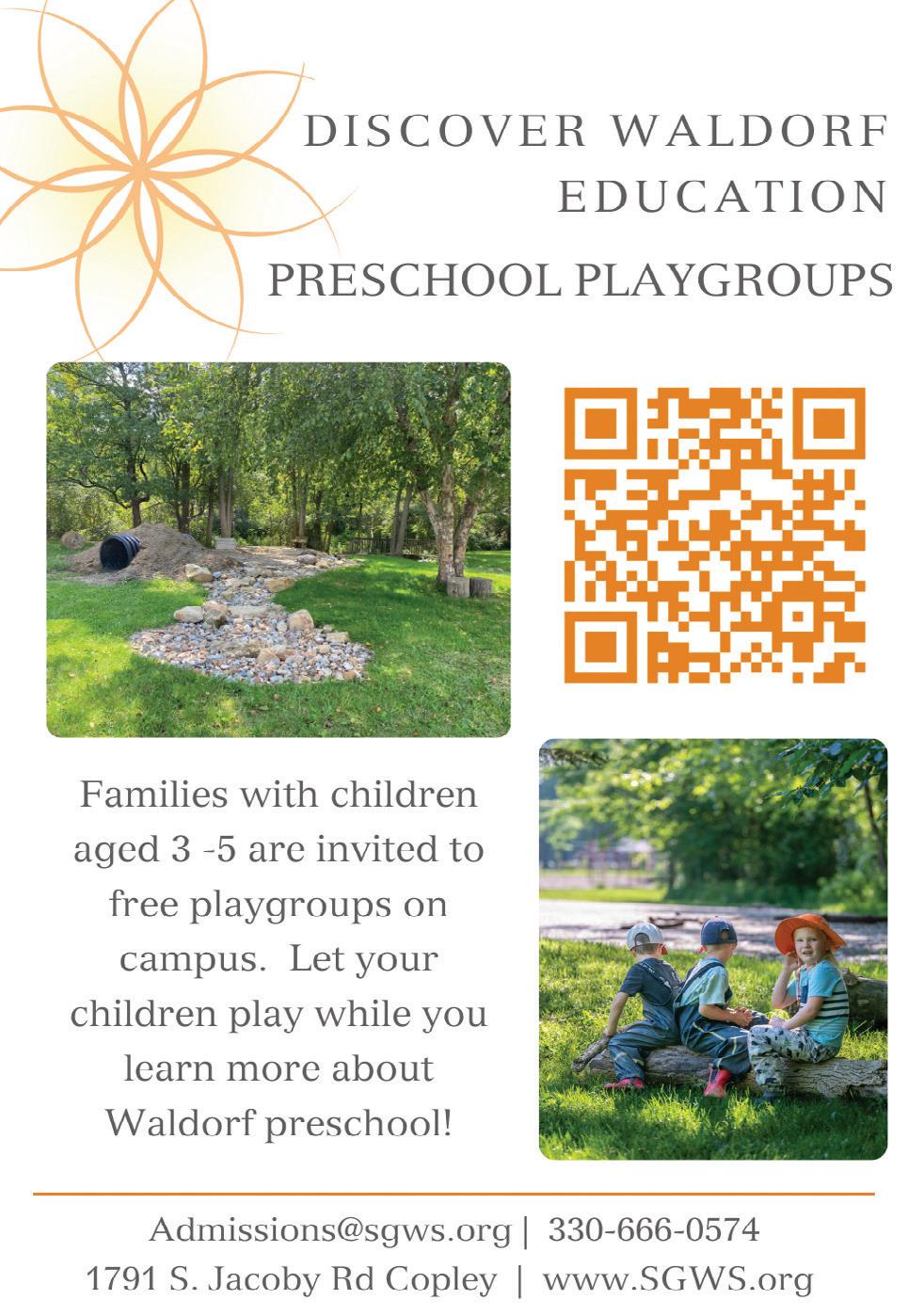
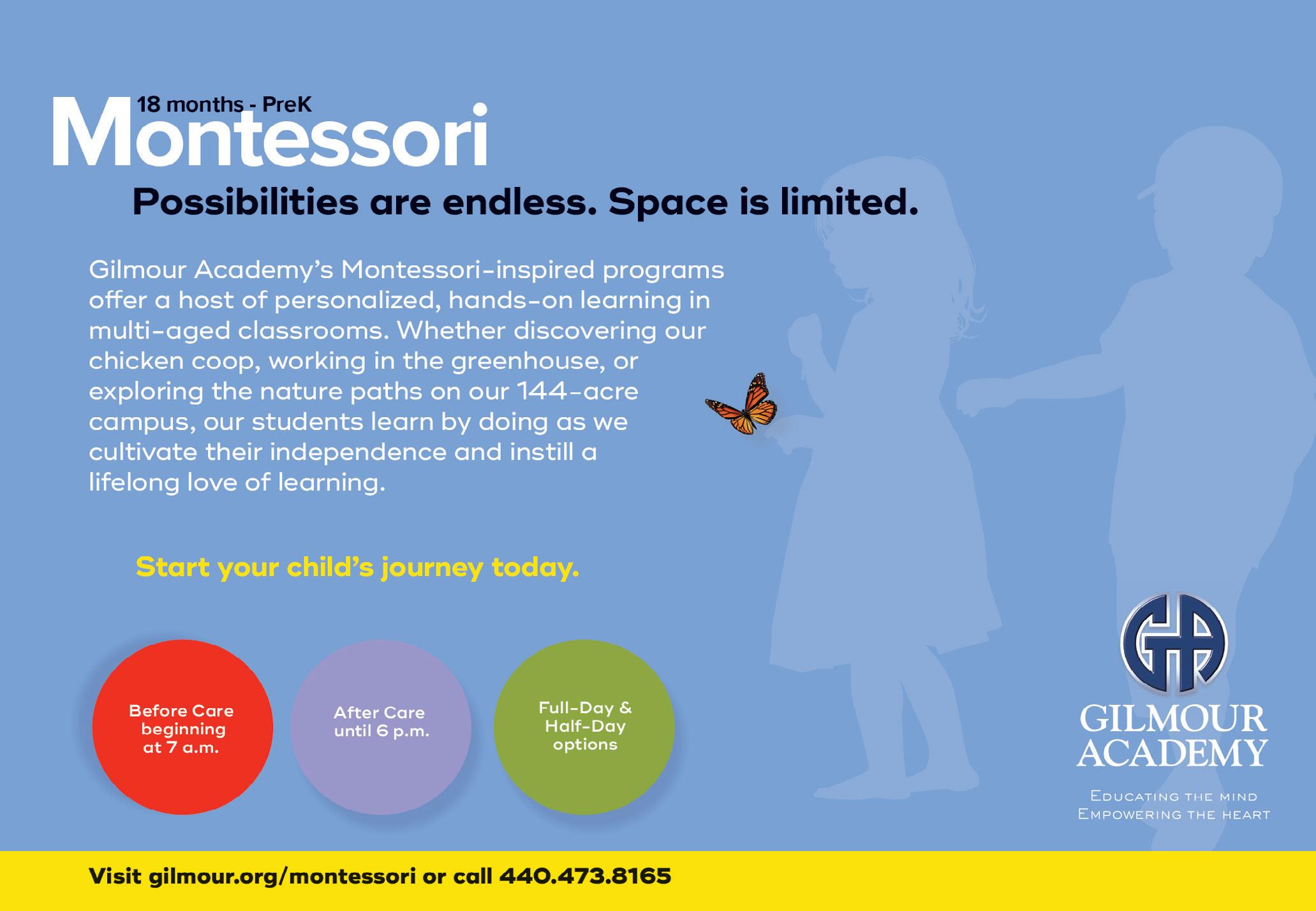

P R ESCHO O L
G U IDE LIS T ING S

BELLEFAIRE JCB’S JDN EARLY CHILDHOOD CENTER

Bellefaire JCB’s JDN Early Childhood Center offers full-day, year-round programming for children 6 weeks to 5 years old. In 2014, JDN became one of the first early childhood program’s to earn Ohio’s Step Up To Quality’s Gold Level rating. JDN fosters academic readiness, confidence, self-control, creativity and a love of learning while its team of educators and staff attend to the social, emotional, cognitive and physical needs of children. Call 216-320-8489 to learn about enrollment. bellefairejcb.org
THE CENTERS

The Centers operates five early learning centers in Northeast Ohio, providing a high-quality educational experience for children 6 weeks to age 5 to prepare them for kindergarten and future success. The early learning centers offer a stimulating learning environment, interactive activities and a team of dedicated and experienced teachers and staff. Welcoming classrooms cater to children of all abilities. Programs are affordable for all families, with payment options for private pay, voucher qualified and early/head start eligible families. 216-325-9678, thecentersohio.org
CHAPEL HILL CHRISTIAN SCHOOL

CHCS Preschool offers a Christ-centered, nurturing environment where children grow in faith, learning and character. Since 1966, they have partnered with families to support each child’s spiritual, social and academic development. With flexible three- or five-day options, daily Bible lessons, weekly chapel and purposeful play, CHCS equips preschoolers to thrive and discover their God-given potential. chapelhillchristianschool.org
CREATIVE PLAYROOMS
Creative Playrooms Montessori and Child Care Centers provide children with a strong foundation for their lifelong learning journey. Their gifted educators inspire children to develop a love for learning, focusing on the development of each child — physically, emotionally and cognitively through both traditional and play-based Montessori approaches. As an award-winning provider with six locations and 50+ years of experience in the Cleveland area, Creative Playrooms offers a variety of programs for infants through school-age children. Visit creativeplayrooms.com
GILMOUR’S MONTESSORI PRESCHOOL PROGRAM

Montessori students enjoy unique opportunities, including Spanish instruction and experiential learning opportunities such as collecting eggs from the chicken coop. Before and after care is available for those who would like to extend their day. The toddler program (18 months to age 3) is three or five days/week, half- or full-day. Pre-kindergarten (ages 3-4)five days/week, half-, three-quarter- or full-day. Students then move seamlessly into the lower school for grades K-6, where they continue to develop as curious learners. gilmour.org
HAWKEN SCHOOL

Hawken School, a co-ed day school
for toddlers through grade 12, offers a nationally recognized early childhood program on its Lyndhurst campus. The school’s forward-focused mission of preparation through the development of character and intellect applies to even its youngest students through a dual commitment to academic and social curricula. Teachers put students at the center of learning by focusing on language development, science inquiry, math awareness, creative arts exploration, and social and emotional growth. For more information, visit hawken.edu
MONTESSORI SCHOOL OF UNIVERSITY HEIGHTS

Montessori School of University Heights, established in 1968, is a pre-primary school dedicated to helping each child become the unique person his/her creator intended in a Christian atmosphere of peace, love and respect. Children enter at age 3 and remain through their kindergarten year. The Montessori approach involves: providing comprehensive, individualized opportunities for growth; engaging children in a caring, supportive community; and developing concentration, independence, self-discipline, compassion, confidence and joy in learning. 216-381-8388, ms-uh.org
THE NEST SCHOOLS
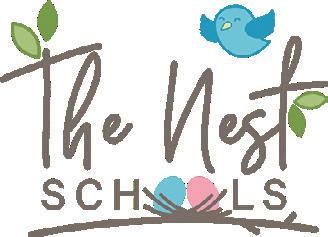
The Nest Schools offers more than preschool — serves as a trusted partner in each child’s growth, learning and happiness. With a proprietary, research-backed curriculum, caring educators and a safe, nurturing environment, children are supported in reaching their full potential. As part of its comprehensive approach, the Nest Play curriculum features three enrichment programs — Fit Buddies, Paints & Pianos, and Art of Living — designed to build confidence, creativity and personal development, all included in the tuition. thenestschools.com
OUR TRIBAL EARLY CHILDHOOD EDUCATION CENTER

Discover Our Tribal ECE Center, a nurturing and safe haven for young learners since 2011. It offer a supportive environment where children thrive, backed by CPR and First Aid certified staff. Our Tribal ECE Center is proud to be now enrolling new students into its cherished program. Akron, 330-733-8300, ourtribalece.com - CONTINUED ON PAGE 34 -

PR ESCHO O L G UI D E LISTINGS
RUFFING
MONTESSORI SCHOOL

Ruffing Montessori School in Cleveland Heights is an exceptional school community for children ages 18 months through eighth grade. Join them for an admissions event or personal tour to explore Ruffing’s beautiful classrooms and spacious outdoor play spaces, meet their Montessori-trained teachers, and learn about Ruffing’s rigorous curriculum that prepares students to lead and excel academically. Schedule a tour today at 216-321-7571 or visit ruffingmontessori.net
SHAKER HEIGHTS CITY SCHOOL DISTRICT
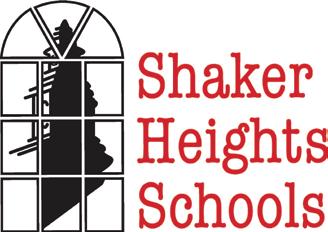
The Ludlow Early Learning Center, part of Shaker Heights Schools, is an International Baccalaureate preschool where children begin their journey as curious, confident thinkers.
Rooted in inquiry and play-based learning, Ludlow nurtures joyful exploration, strong social-emotional growth and global awareness. With dedicated educators and inclusive, engaging classrooms, children build the skills they need for kindergarten and beyond. At Ludlow, learning is handson and community-centered. Learn more at shaker.org/preschool.
SPRING GARDEN WALDORF SCHOOL

Spring Garden Waldorf School is one of only two accredited Waldorf schools in Ohio, and they have been educating children from the surrounding five-county area for 44 years. Families come to Waldorf education because they’re ready for something different. Their curriculum challenges students with hands-on learning, critical thinking and creative expression. By engaging the whole child with a multi-disciplinary approach, they nurture a lifelong passion for learning. Discover education that engages, inspires, and empowers! sgws.org
STARTING POINT

For 35 years, Starting Point has been Northeast Ohio’s leading expert in quality child care, early education and after-school resources. Whether you’re a parent trying to find child care or preschool that works for you, an early childhood educator, a business that wants to explore child care solutions, or someone interested in opening a child care program, we’re your starting point. Call them at 216-575-0061 to explore options.
VALLEY CHRISTIAN ACADEMY
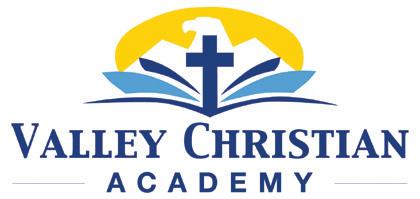
Valley Christian Academy is a private, Pre-K through 5th grade school in Aurora, Ohio. VCA offers a Christ-centered, loving environment with challenging academics. The quiet and caring environment is home to enrichment programs, a one-of-a-kind STEAM strategy, extracurriculars and so much more. Schedule a visit today. 330-562-8191, valleychristian.com
